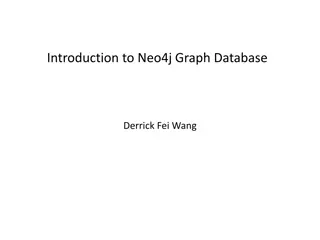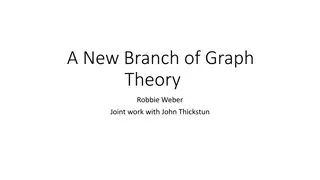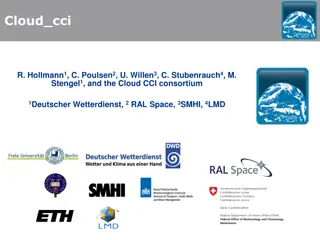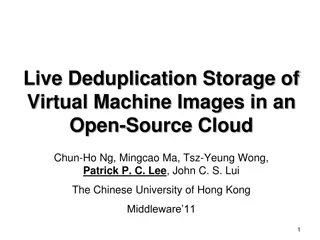Comparing Scale-Up vs. Scale-Out in Cloud Storage and Graph Processing Systems
In this study, the authors analyze the dilemma of scale-up versus scale-out for cloud application users. They investigate whether scale-out is always superior to scale-up, particularly focusing on systems like Hadoop. The research provides insights on pricing models, deployment guidance, and performance metrics for systems such as Apache Cassandra and GraphLab.
Download Presentation

Please find below an Image/Link to download the presentation.
The content on the website is provided AS IS for your information and personal use only. It may not be sold, licensed, or shared on other websites without obtaining consent from the author.If you encounter any issues during the download, it is possible that the publisher has removed the file from their server.
You are allowed to download the files provided on this website for personal or commercial use, subject to the condition that they are used lawfully. All files are the property of their respective owners.
The content on the website is provided AS IS for your information and personal use only. It may not be sold, licensed, or shared on other websites without obtaining consent from the author.
E N D
Presentation Transcript
1 SCALE UP VS. SCALE OUT IN CLOUD STORAGE AND GRAPH PROCESSING SYSTEMS Wenting Wang Le Xu Indranil Gupta Department of Computer Science, University of Illinois, Urbana Champaign
2 Scale up VS. Scale out A dilemma for cloud application users: scale up or scale out? Scale up: one machine with high hardware configuration Scale out: cluster composed by wimpy machines
3 Scale up VS. Scale out Systems are designed in a scaling out way Question: Is scale out always better than scale up? Scale-up vs Scale-out for Hadoop: Time to rethink?(2013) A single scale-up server can process each of these jobs and do as well or better than a cluster in terms of performance, cost, power, and server density What about other systems?
4 Contributions Set up pricing models using public cloud pricing scheme Linear Square fit on CPU, Memory and Storage Estimation for arbitrary configuration Provide deployment guidance for users with dollar budget caps or minimum throughput requirements in homogeneous environment Apache Cassandra, the most popular open-source distributed key- value store GraphLab, a popular open-source distributed graph processing system
5 Scale up VS. Scale out - Storage Cassandra Metrics Throughput: ops per sec Cost: $ per hour Normalized Metric Cost efficiency = Throughput / Cost
6 Scale up VS. Scale out - Storage YCSB workload Yahoo Cloud Serving Benchmark: A database micro-benchmark tool Read heavy, write heavy workload on Zipf Distribution 1 Million operations on 1GB database Metrics: Performance(Ops/s), Cost($/hour) and Cost efficiency Homogeneous Experiment Settings: Scale out cluster: 4, 8, 16 machines (0.09$/hour) Scale up machine(3.34$/hour) Heterogeneous Experiment Settings: A mixture of beefy and wimpy machines Cost(beefy) = Cost(wimpy) X 4
7 Homogeneous - Cassandra Budget-constrained Min throughput requirement Light workloads Scale out with small number of nodes If throughput low Scale out Else Scale up Heavy workloads If $ constraint low Scale out is only option Else Scale up Scale up
8 Homogeneous - Cassandra Performance(Ops/s) Main variable tuned: Workload intensity, scale out cluster size - With a high threshold of throughput requirement, scale up is preferable
9 Homogeneous - Cassandra Cost 4 8 16
10 Homogeneous - Cassandra Cost Efficiency Main variable tuned: Workload intensity, scale out cluster size
11 Homogeneous - Cassandra - Light workload: Scale out cluster has a better cost efficiency comparing to scale up while cluster size is small. - Heavy workload: scale up is always better in terms of cost efficiency - In terms of scale out size, small is always better Scale up & Scale out under different workload intensity
12 Homogeneous - Cassandra Budget-constrained Min throughput requirement Light workloads Scale out with small number of nodes If throughput low Scale out Else Scale up Heavy workloads If $ constraint low Scale out is only option Else Scale up Scale up
13 Heterogeneous - Cassandra Main variable tuned: machine ratio, workload intensity - Adding one beefy node to the cluster significantly improves throughput, as the node serves as a contact point - Lower marginal benefits while the number of beefy nodes increases Machine Ratio (# of beefy nodes : # of wimpy nodes) VS. Cost Efficiency under different workload intensity
14 Heterogeneous - Cassandra Main variable tuned: vnode ratio, workload intensity - Under light workload, performance increases as the beefy node partition grows - Under intense workload, beefy node becomes the bottleneck for the entire system. Vnode Rate (# of wimpy nodes Vnode : # of beefy nodes Vnode) VS. Cost Efficiency under different workload intensity (machine ratio 1:12)
15 Scale up VS. Scale out - GraphLab GraphLab Metrics Throughput: MB per sec Cost: Total $ for a workload since batch processing system Normalized metric Cost efficiency = Throughput / Cost
16 Experimental Settings Page Rank Job Data set Input |V| |E| Small Large Live Journal Twitter 1G 6G 4.8M 41.6M 68M 1.5G Homogeneous Settings One scale up machine(3.34$/hour) Two scale out clusters with 4, 8, 16 machines Weak configuration (1 core/machine) pc3000 (0.09$/hour) Strong configuration (4 cores/machine) d710 (0.34$/hour) Heterogeneous Settings A mixture of beefy and wimpy machines
17 Homogeneous - GraphLab Budget-constrained Min throughput requirement Small Jobs Scale out with small number of nodes (allow parallelization) Scale out with small number of nodes Large jobs Scale up Scale out with large number of nodes
18 Homogeneous - GraphLab Performance(MB/s) Small job Large job - - Minimum requirement for the quality of scale out cluster Scale out performs better than scale up
19 Homogeneous - GraphLab Cost= completion time * cluster/ scale up machine unit price Small job Large job - Beefy machine is sometimes the cheapest choice
20 Homogeneous - GraphLab Cost Efficiency (Throughput/$) Small job Large job - Scale out cluster in small size achieves best cost efficiency
21 Homogeneous - GraphLab Budget-constrained Min throughput requirement Small Jobs Scale out with small number of nodes (allow parallelization) Scale out with small number of nodes Large jobs Scale up Scale out with large number of nodes
22 Heterogeneous - GraphLab ? ? # ??? ???? ??? ???? ? ? ?????? ?? ????? ??? ????with fixed budget ? ? # ?? ????????? ?? ? ???? ??? ??? ? ? ?????? ?? ????????? ?? ????? ??? ??? Vary Vary - Better cost efficiency can be achieved by - More processes running on beefy machine - Fewer wimpy machines(stragglers)
23 To sum up What have we done: Pricing model based on major cloud providers General guidance between scale up vs. scale out The choice is sensitive to workload intensity, job size, dollar budget, and throughput requirements Explore implications when using heterogeneous mix of machines Future work A quantitative way to map hardware configuration to cost efficiency Latency, network usage, resource utilization/profiling, fault tolerance And many more Find our work at http://dprg.cs.uiuc.edu
24 Back up
25 How do we set up the pricing model From AWS pricing March -2014 VCPUcount MemorySize (GiB) SSD StorageSize (GiB) 32 80 160 320 Price per hour ($) 7 14 28 55 3.75 7.5 15 30 0.15 0.3 0.6 1.2 Linear least square fit, using three variables: CPU, memory, storage
Linear Pricing Model AWS instance pricing model VCPU in SSD model ($/count) 0.0094 Memory in SSD model ($/GiB) 0.0208 SSD Storage ($/GiB) VCPU in non SSD model ($/count) 0.0155 Memory in non SSD model ($/GiB) 0.0106 Non SSD Storage ($/GiB) 0.0001 0.002 VCPUcount MemorySize (GiB) SSD Storage Size (GiB) Price per hour ($) Linear model estimation ($) Error ($) 7 3.75 32 0.15 0.1504 +0.004 6.5 7.5 32 0.225 0.2237 -0.0013 13 15 80 0.45 0.4507 +0.007 108 60 640 2.4 2.3940 -0.006 VCPUcount MemorySize (GiB) Non SSD StorageSize (GiB) Price per hour ($) Linear model estimation ($) Error ($) 2 3.75 410 0.12 0.1190 -0.001 20 7 1680 0.58 0.5817 +0.0017 88 60.5 3360 2.4 2.4001 +0.001
27 Contribution of our work Setting up pricing model Storage (Cassandra) Homogeneous: Scale out using a small cluster only when there is a dollar budget cap and low throughput requirements, scale up in any other cases. Heterogeneous: beefy node is preferable, assigning larger data partition to the beefy node without overwhelms it. Graph processing GraphLab performance and cost efficiency under homogeneous environment GraphLab performance and cost efficiency under heterogeneous environment























